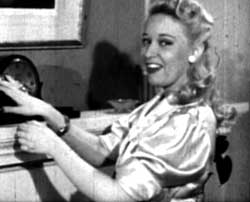 Little-known vocalist Nita Norman is shown standing in a living room watching the clock & singing Mailman Blues (Looking for a Letter from You) (1942), a competent but uninspired performance of an adequate swing song.
Little-known vocalist Nita Norman is shown standing in a living room watching the clock & singing Mailman Blues (Looking for a Letter from You) (1942), a competent but uninspired performance of an adequate swing song.
The unseen back-up band is Frank Denning & His Orchestra, which was hardly more than a soundies house band.
The lyrics run in part: "I sit in the corner twiddling my thumbs/ Watching the clock until the mailman comes/ Why must I fret & worry like I do/ Looking for a letter from you."
Nita has a Ginger Rogers look & is acting up a storm interacting with the set, literally twiddling her thumbs, sitting, standing, setting the clock, cutting away to alternate sets, climbing out of the bathtub-shower, answering the front door with the mail man who sings a line to her flirtatiously, going to the post office where a a three-man harmony group sings about her not getting any letters.
The harmony group of mailmen look straight at the audience for an extended bit that goes in part, "If it's you or you or you/ Who's making this poor little girl feel blue/ Please write her a line or two/ Cuz we've got a lot of other work to do."
The implication is that she's waiting for a letter from a soldier, & a poster promoting the purchase of war bonds can be seen at the post office. Definitely not one of the the better soundies despite the complexity of the production.
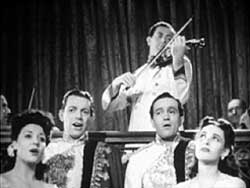 Emery Deutsch & His Orchestra constituted a romantic string orchestra who made four soundies. In Love's Own Sweet Song (1941) they are shown performing in a trumped-up sitting-room for maidens in long flouncy gowns vaguely evocative of a European court.
Emery Deutsch & His Orchestra constituted a romantic string orchestra who made four soundies. In Love's Own Sweet Song (1941) they are shown performing in a trumped-up sitting-room for maidens in long flouncy gowns vaguely evocative of a European court.
Then a singing group of two men & two women in period costume begin singing "Oh let us come & dance with joy/ Since life & love are ours/ For youth is strong & blood grows warm/ Beneath the scented flowers."
Love's Own Sweet Song is the closing waltz number from a 1914 operetta musical, music by the Viennese composter Emmerich Kalman, English lyrics by C. C. S. Cushing & E. P. Heath. The setting was the Paris home of Count Irini.
It was old-fashioned when Kalman first composed it & was adapted in piano parlor songbooks as an old-timey number even when newly written. Emery Deutsch was himself from Hungary & doubtless welcomed this opportunity to perform his countryman's composition on film.
After the somewhat squally rendition of the lyrics, Emery Deutsch on lead violin plays to a brief scene of guests waltzing in their period costumes. The dancing does add a note of glamor to the setting, though this is otherwise a pretty lame production.
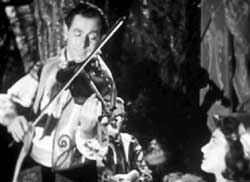 Hungarian Dance (1941) was included on a cheaply, hastily, poorly dashed together collection of soundies & telescriptions, The Swing Years: Lullaby of Broadway (2004), as "Dance Gypsy Dance" by "Unknown." Hungarian Dance (1941) was included on a cheaply, hastily, poorly dashed together collection of soundies & telescriptions, The Swing Years: Lullaby of Broadway (2004), as "Dance Gypsy Dance" by "Unknown."
It happens to be Emery Deutsch & His Orchestra who made rather classicist violin soundies, probably directed by Frederick Feher who was the "classical" director among early soundie productions.
Emery clad more or less as a gypsy could almost pass for an authentic gypsy captured on film, but his orchestra & the dancers were less skilled at faking it. It's instantly recognizable as a phony set-up when two "gypsy" couples begin dancing, wearing not gypsy costumes, but truly ugly-ass ho-down outfits.
Then out jumps one of the most inept tambourine acts ever danced by a fake gypsy. She leaps center stage with her tambourine, it sounds like a couple boxes of Christmas bells fell from a high shelf into a sack of shit.
The poor girl does whirl & jump nicely, & might've turned in a better dance if not for trying to incorporate the tambourine about which she has no clue.
That dancer, shockingly enough, is Beth Dean, a well-known ballerina who was born in Denver & trained with Leo Staats at the Paris Opera Ballet before setting out to many achievements as ballet dancer & choreographer. But from this one soundie you'd never guess she was anyone but a random chorus girl, & we can only wonder who convinced her to try her hand at something totally unrelated to her training.
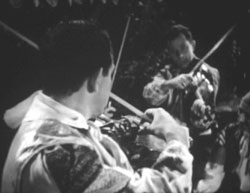 Emery Deutsch & His Orchestra again performs in a "gypsy camp" setting with gypsy costumes, Emery at his violin.
Emery Deutsch & His Orchestra again performs in a "gypsy camp" setting with gypsy costumes, Emery at his violin.
He & his fellow "gypsies" are peforming a medly of two numbers in Two Guitars/Dark Eyes (1941).
Faux gypsy couples are shown seated about the camp, hugging, listening to the very attractive rendiition of "Two Guitars."
We are shown two violinists (including Emery) but no guitars. The young men of the coupled audience are humming along.
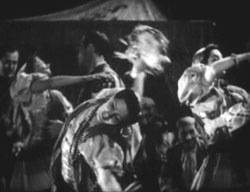 Suddenly a couple leaps into a firelit circle to dance a spirited & thrilling dance. Suddenly a couple leaps into a firelit circle to dance a spirited & thrilling dance.
A second gypsy woman joins in the dance, leaping about with her tambourine, then a second couple enters the firelit circle to dance.
This dance troupe is the same as seen in Hungarian Dance but they seem better this time through.
The tambourine maiden, Beth Dean, was a well trained ballet performer, yet she is not a particularly great dancer if judged by her two soundies appearances. She's better dancing to "Two Guitars" than she had been in Hungarian Dance, however, & very pretty to watch.
There's a momentary break in the instrumentation, then everyone in the camp begins to sing "Dark Eyes" in English, before all the dancing begins anew for a big finale.
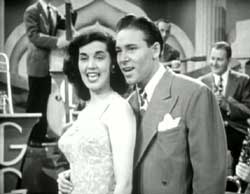 Glen Gray & His Casa Loma Orchestra back the duet of Eugenie "Jeanie" Baird & Bob Anthony in Sentimental Journey (1945). Glen Gray & His Casa Loma Orchestra back the duet of Eugenie "Jeanie" Baird & Bob Anthony in Sentimental Journey (1945).
It's a classic slow swing number well known to this day -- "Gonna take a sentimental journey/ Gonna set my heart at east..." -- but this duet doesn't do it a lot of justice. They're like a couple Lawrence Welk singers on a bad night.
They're attractive in a dullard way, & Bob Anthony's marginally a better singer than Baird, who for a while had a regular gig on the Bing Crosby radio show.
At the instrumental break, the singers rush off stage, & mustachioed Glen Gray conducts a perfectly decent arrangement. This would've been a better soundie without the singers at all. And it'd be fine for slow dancin'.
This soundie was included in the Official Films home-movie one-reeler Sentimental Journeys (1947) together with Sonny Durham & His Orchestra's Sleepy Lagoon (1942) & the Dinning Sisters' holiday number Winter Wonderland (1945).
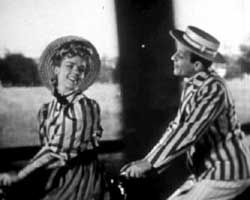 The Eton Boys came up with their name by spelling "Note" backwards. They were popular radio performers in their day, consisting of Earl Smith first tenor, Art Gentry second tenor, Jack Day baritone & Charles Day bass.
The Eton Boys came up with their name by spelling "Note" backwards. They were popular radio performers in their day, consisting of Earl Smith first tenor, Art Gentry second tenor, Jack Day baritone & Charles Day bass.
They did several soundies & a couple "follow the bouncing ball" sing-along cartoons with Fleischer Studios. But if they've left only a small legacy, it's because they deserved no big one.
A Bicycle Built For Two (1941) is sung on a sound stage tricked out to look like an outdoor scene. The Eton Boys start out seated in a park-like environment with their girlfriends, then are shown riding stationary bicycles built for two along with their gals in front of a rear-projection screen, passing split-railed pastures.
They wear the cliche barbershop outfits of striped jackets, & three of the guys sport handlebar mustaches. Their sound is nostalgia-based & cliche. The unseen back-up band is soundies house band Ray Bloch & His Orchestra.
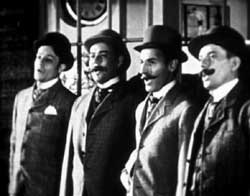 The Eton Boys out in front of a barber shop in bowlers do the barbershop quartet standard My Gal Sal (1941), pretty much proving that if you've heard one barbershop performance you've heard a thousand.
The Eton Boys out in front of a barber shop in bowlers do the barbershop quartet standard My Gal Sal (1941), pretty much proving that if you've heard one barbershop performance you've heard a thousand.
The old tune has a certain sweetness, however, & I enjoyed listening to the Eton Boys sing it with tragedy in their voices. The only Eton without a mustach has a solo that's stronger than their barbershop harmonizing in general.
There's a jump-cut from their singing on the sidewalk to three guys indoors playing slap-bass, piano, & guitar, also mustachioed & in bowlers. These guys are the Claude Garreau Trio & they're musically much more interesting than the singers, although put them altogether, it's not a bad act.
My Gal Sal was included in the Castle Films home-movie three-soundie compilation Gay Nineties Songs (1945) with two other pieces by the Eton Boys, namely I Want a Girl (1941) featuring Geraldine DuBois as the wanted girl like the one who married dear old dad, with the harmonists again backed up by the Claude Garreau Trio; & the barbershop chestnut A Bicycle Built for Two reviewed above.
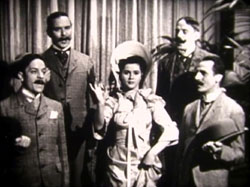 For I Want a Girl the Eton Boys are in their best barbershop duds & holding their bowler hats in crooks of their arms perform the number as traditionally as they can muster. For I Want a Girl the Eton Boys are in their best barbershop duds & holding their bowler hats in crooks of their arms perform the number as traditionally as they can muster.
Whether that's a good thing or a bad thing is a matter of taste, but they do it with as much appeal as standardized barbershap can possess.
Geraldine du Bois rises up from where she was apparently squatted down taking a dump between the lads. She's got on a bonnet & some loose fitting clothes to sort of fit the Victorian tune, but the costome is rather unattractive.
The lads keep singing while gazing at her, & we can't help but wonder if the loose clothes aren't break-away since soundies delight in half-clad beauties.
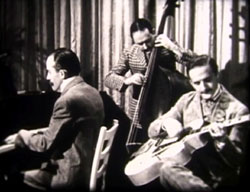 The Eton Boys could certainly do this number a-capela but they don't. They're backed by the Claude Garreau Trio, which means we can have an instrumental break from the vocal harmony. The Eton Boys could certainly do this number a-capela but they don't. They're backed by the Claude Garreau Trio, which means we can have an instrumental break from the vocal harmony.
We see the trio (piano, double bass, guitar) playing in full spirit of Victoriana & they have unquestionable appeal, as they really seem to have put themselves in a very old-timey "saloon performance" mood.
As it turns out, Geraldine's costume is not break-away, but fade-away in a simple special effect. Suddenly she's in something approaching a little Dutch girl outfit. The Eton Boys pick up the pace of the tune, making it jazzy enough for Geraldine to dance & wiggle.
She moves to her own curtain & dances her heart out, then returns to her place between the lads & her Victorian gown re-materializes. Honest to gosh this one was all rather thrilling.
copyright © by Paghat the Ratgirl
|
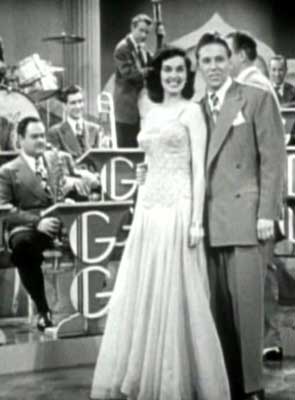




 Suddenly a couple leaps into a firelit circle to dance a spirited & thrilling dance.
Suddenly a couple leaps into a firelit circle to dance a spirited & thrilling dance.



 The Eton Boys could certainly do this number a-capela but they don't. They're backed by the Claude Garreau Trio, which means we can have an instrumental break from the vocal harmony.
The Eton Boys could certainly do this number a-capela but they don't. They're backed by the Claude Garreau Trio, which means we can have an instrumental break from the vocal harmony.